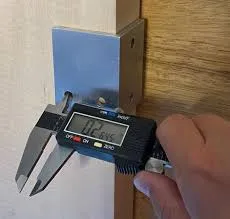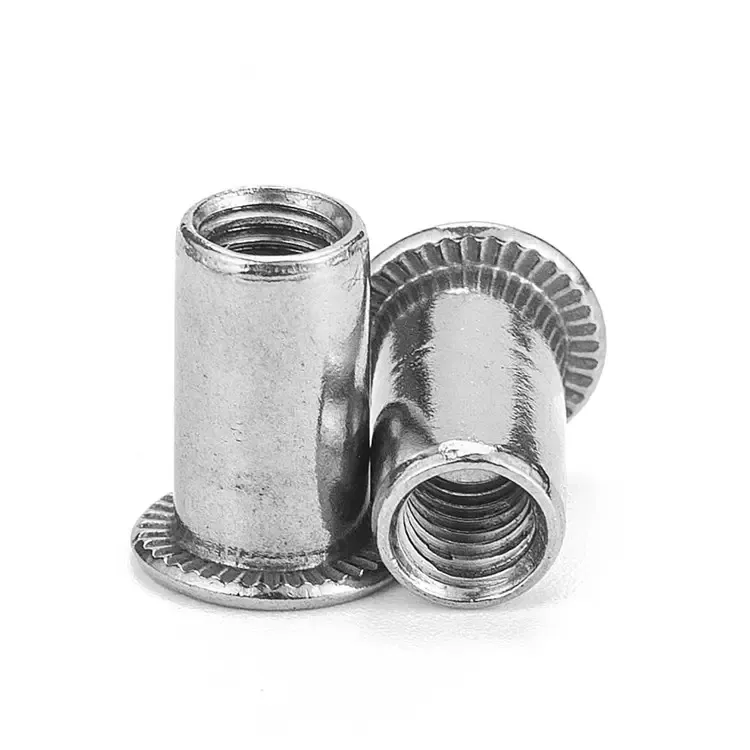Rivet Nut Drill Bit Size Chart
This chart is a technical reference table used to match the correct drill bit size with a specific rivet nut (also known as a rivnut or blind nut). It plays a crucial role in ensuring that the rivet nut can be properly inserted and securely fastened into the pre-drilled hole without being too loose or too tight.
Metric Rivet Nut Drill Bit Size Chart
| Nut Size | Thread (Metric) | Body Diameter (mm) | Recommended Hole Size (mm) | Grip Range (mm) |
| M3 | M3 x 0.5 | 4.8 – 5.0 | 5.1 – 5.3 | 0.5 – 2.0 |
| M4 | M4 x 0.7 | 5.9 – 6.1 | 6.2 – 6.4 | 0.5 – 2.5 |
| M5 | M5 x 0.8 | 6.8 – 7.0 | 7.1 – 7.3 | 0.5 – 3.0 |
| M6 | M6 x 1.0 | 8.8 – 9.0 | 9.1 – 9.3 | 0.5 – 3.5 |
| M8 | M8 x 1.25 | 10.8 – 11.0 | 11.1 – 11.3 | 0.5 – 4.0 |
| M10 | M10 x 1.5 | 12.8 – 13.0 | 13.1 – 13.3 | 1.0 – 5.0 |
| M12 | M12 x 1.75 | 14.8 – 15.0 | 15.1 – 15.3 | 1.0 – 6.0 |
Inch Rivet Nut Drill Bit Size Chart
| Nut Size | Thread (Inch) | Body Diameter (inch) | Recommended Drill Size | Grip Range (inch) |
| #6-32 | 6-32 UNC | 0.255 – 0.260 | #F Drill (0.257”) | 0.020 – 0.080 |
| #8-32 | 8-32 UNC | 0.280 – 0.285 | #H Drill (0.266”) | 0.020 – 0.120 |
| #10-24 | 10-24 UNC | 0.312 – 0.318 | #I Drill (0.272”) | 0.020 – 0.120 |
| #10-32 | 10-32 UNF | 0.312 – 0.318 | #I Drill (0.272”) | 0.020 – 0.120 |
| 1/4”-20 | 1/4-20 UNC | 0.350 – 0.360 | 11/32” (0.344”) | 0.020 – 0.150 |
| 5/16”-18 | 5/16-18 UNC | 0.410 – 0.420 | 13/32” (0.406”) | 0.020 – 0.200 |
| 3/8”-16 | 3/8-16 UNC | 0.470 – 0.480 | 1/2” (0.500”) | 0.030 – 0.250 |
| 1/2”-13 | 1/2-13 UNC | 0.620 – 0.630 | 21/32” (0.656”) | 0.030 – 0.300 |
⚠️ Notes:
- The recommended hole diameter should be slightly larger than the rivet nut body, typically +0.1mm to +0.3mm, to allow easy insertion while preventing looseness.
- For hex or knurled rivet nuts, additional hole shaping is required, such as hex punching or anti-rotation slots.
- If using inch drill bits (e.g., #F, #I), consult a drill number-to-metric chart to ensure proper conversion and compatibility.
- It is highly recommended to measure hole size using gauges or calipers before installation to ensure compliance with the recommended range, improving success rate and reliability.
Have more questions?
Contact us for technical support, advice and quotes.
Why Drill Bit Size Matters
The hole size determines the clamping force and peeling force of the rivet nut. If the hole is too small, the force distribution during riveting will be uneven, causing deformation, eccentricity or jamming. If the hole is too large, the contact area will be insufficient, resulting in a decrease in anti-torque, and the rivet nut is prone to rotation or loosening.
Rivmate test shows that the hole diameter exceeds the recommended value by 0.2 mm, and the anti-torque decreases by approximately 20%. The correct hole diameter enables the nut to undergo uniform plastic deformation in the base material, maintaining a stable connection.


How to Measure Proper Hole Size
Recommended measuring tools:
- Micrometer Caliper: Quickly measures the hole diameter with an accuracy of ±0.02 mm.
- Gauge Block: Used for batch inspection. A “gauge block” that passes and a “stop gauge” that fails are considered qualified.
It is recommended that the aperture tolerance be controlled within ±0.05 mm.
When measuring, please note: the hole opening should be free of burrs, the hole wall should be smooth, and the verticality error should not exceed 2°. In high-precision applications, it is recommended to use the Rivmate calibration gauge for quick re-inspection.
Material Considerations
| Rivet Nut Material | Base Material | Hole Adjustment | Note |
|---|---|---|---|
| Aluminum | Steel / Stainless Steel | Recommended size or 0.05 mm smaller | Soft material, expands easily |
| Steel | Aluminum / Soft Metals | 0.05 mm larger | Prevents base material cracking |
| Stainless Steel | Stainless Steel | 0.1 mm larger | High friction, needs looser fit |
| Brass | Aluminum / Copper | Recommended size | Suitable for light-load applications |
The installation torque of stainless steel rivet nuts is about 35% higher than that of aluminum rivet nuts.
Before mass production, always perform a Trial Fit Test to confirm proper hole size and performance consistency.
Does Material Type Affect Drill Size Selection?
Yes, the type of material being drilled has a direct impact on drill size selection. Different materials possess unique physical properties such as hardness, elasticity, and thermal behavior, which can influence hole accuracy, edge quality, and the overall success of rivet nut installation. As a result, slight adjustments to the recommended drill size may be necessary based on the material.
a. Steel Sheet
- Material Properties: High hardness and stability; drilled holes are typically precise with minimal deformation.
- Drilling Suggestion: Standard recommended drill sizes are generally sufficient.
- Notes: Use high-speed steel (HSS) or carbide drill bits to minimize wear during drilling.
b. Aluminum Sheet
- Material Properties: Softer than steel; prone to thermal expansion during drilling, which may slightly enlarge the hole or deform edges.
- Drilling Suggestion: A drill bit slightly smaller (about 0.1mm less) than the standard size may compensate for thermal expansion.
- Notes: Drill at lower speeds and use lubricants to reduce burrs and heat buildup.
c. Plastic Sheet
- Material Properties: Very soft and flexible; drilling can cause stringing, melted edges, or shrinking around the hole.
- Drilling Suggestion: Use special drill bits designed for plastics, and allow for tighter hole tolerance control.
- Notes: Avoid high-speed drilling to prevent melting and hole distortion.
Can All Rivet Nuts Use Round Holes?
Not all rivet nuts are suitable for round holes. Different rivet nut types have specific requirements for hole shapes, which are essential to ensure secure fastening and prevent loosening or rotation. Below is a detailed explanation of common rivet nut types and their corresponding hole shape requirements:
- Hole Requirement: Standard round hole.
- Application: General-purpose use; easy to install and suitable for most materials.
- Anti-Rotation Capability: Relies on clamping force and surface friction. However, in softer materials like plastic or aluminum, the anti-rotation effect is weaker.
- Hole Requirement: Standard round hole.
- Special Design: Features longitudinal ridges or splines on the outer surface.
- Advantages:
- Enhances grip against the hole wall;
- Improves anti-rotation performance in soft or coated materials;
- Less likely to rotate after installation compared to plain body nuts.
- Hole Requirement: Requires a properly sized hexagonal hole or a stamped hex hole.
- Main Advantage: Provides excellent anti-rotation performance, ideal for applications with vibrations or high torque loads.
- Note: Hex holes require precise machining, making them more suitable for mass production environments.
When installing rivet nuts, selecting the correct drill bit size to precisely match the nut body diameter is essential to ensure a secure and reliable installation. Common drill bits fall into two main systems: Metric and Inch (Numbered/Lettered). Below are common types and their typical uses:
Metric Drill Bits
- Common sizes include:
- 6.0mm, 6.3mm, 6.9mm, 7.0mm, 7.3mm, 8.5mm, 9.1mm, 10.2mm, 12.1mm, etc.
- Applications:
- Suitable for most domestic and international standard metric-thread rivet nuts (e.g., M4, M5, M6, M8, M10).
- Advantages:
- High precision and intuitive units;
- Compatible with European and Asian threading standards;
- Widely supported by various industrial standards.
Inch Drill Bits
- Mainly three types:
- Numbered (e.g., #11, #7, #3)
- Lettered (e.g., F drill, H drill)
- Fractional (e.g., 1/4″, 5/16″, 3/8″)
- Common examples:
- #11 Drill (approx. 5.0mm diameter): often used for #10-24, M5 nuts;
- F Drill (approx. 6.51mm diameter): suitable for 1/4″-20 inch rivet nuts;
- 17/64″ Drill (approx. 6.75mm diameter): can be used for M6 nuts.
- Applications:
- Used mainly in North America or industries using inch-thread systems;
- For SAE threads or custom inch-thread fasteners.
Selection Tips:
- For metric rivet nuts, prioritize metric drill bits to avoid conversion errors;
- For inch rivet nuts (such as 1/4″-20), consult the rivet nut drill size chart to select the corresponding inch drill bit;
- If inch drill bits are unavailable, close-sized metric drill bits can be used with caution regarding tolerance;
- It is recommended to verify the drill bit diameter with a caliper before use to ensure it matches the recommended hole size.
What Tools Are Recommended for Drilling and Installation?
Choosing the right tools during the drilling and installation process of rivet nuts is crucial for ensuring quality and efficiency. Below are common and recommended tool types along with their functions:
① Electric Drill
- Purpose: Used for drilling holes to prepare for rivet nut installation.
- Requirements: It is recommended to use a drill with adjustable speed and torque control to avoid over-drilling or damaging the material.
- Note: The hole size must meet the recommended dimensions to ensure the rivet nut fits smoothly without looseness.
② Caliper
- Purpose: Used for precise measurement of the drilled hole diameter and the rivet nut body size.
- Importance: Ensures the hole diameter matches the rivet nut diameter to prevent installation failure caused by holes that are too large or too small.
③ Torque Control Tools
- Purpose: Controls the torque applied during installation to ensure the rivet nut is properly tightened.
- Advantages: Prevents overtightening that could damage the nut or undertightening that compromises joint strength.
- Application: Especially suitable for industrial mass production or applications requiring high joint strength.
④ Electric or Pneumatic Rivet Nut Tools
- Purpose: Specifically designed for fast and efficient rivet nut installation.
- Features: Labor-saving and high-speed installation, ideal for large-scale production.
- Advantages: Some advanced models come with adjustable torque settings for more precise and reliable installation.
- Limitations: Requires power or air supply, suitable for fixed work environments.
FAQs
1. If the drill hole is too large, what should I do?
If the hole is larger than the recommended size, the rivet nut may spin or fall out during installation or under load. Here are possible solutions:
- Use a larger-size rivet nut that fits the oversized hole.
- Switch to a rivet nut with anti-rotation features, such as a hex-body nut (if compatible with the hole shape).
- Apply adhesive (like epoxy) to improve holding strength, though this is not ideal for structural applications.
- Use a knurled or splined rivet nut that grips better in slightly oversized holes.
2. Can I use a metric drill bit for an inch-size rivet nut?
Yes, but with caution. You can use a metric drill bit that closely matches the recommended imperial size. For example:
- A #11 drill bit is approximately 7.0 mm.
- A 6.9 mm bit may work for a 17/64″ hole requirement.
Tips:
- Always check the manufacturer’s recommended hole size.
- Use a caliper to confirm the actual drill bit diameter.
- Perform a test fit before batch installation.
3. Are grip ranges flexible or fixed?
Grip ranges are fixed and specified for each rivet nut type and size. Installing a rivet nut outside of its rated grip range can lead to:
- Improper deformation during setting.
- Reduced pull-out or spin-out resistance.
- Failure under load or vibration.
Always check the grip range and choose a rivet nut that matches the thickness of the material being joined. For example:
- If your sheet is 1.5 mm thick, select a rivet nut with a grip range of 1.0–2.0 mm.
4. Can I reuse a rivet nut after removal?
Generally, rivet nuts are designed for one-time installation. Once they are deformed and expanded to grip the base material, they can’t return to their original shape. Reuse is not recommended because:
- The threads or body may be damaged during removal.
- Holding strength is significantly reduced if reused.
- Structural or safety-critical applications require new rivet nuts for reliable performance.
If frequent disassembly is needed, consider using threaded inserts or riveted studs instead.
5. What’s the difference between countersunk, flat head, and reduced head rivet nuts?
These head styles affect the appearance, installation method, and space requirement:
- Flat Head:
- Offers strong bearing surface.
- Ideal for soft or thin materials.
- Common in general applications.
- Countersunk Head:
- Sits flush with the surface after installation.
- Requires pre-drilled countersink.
- Best for applications where a smooth finish is needed.
- Reduced Head:
- Takes up less space on the surface.
- Suitable for tight or recessed mounting areas.
- May offer lower pull-through resistance.




